If you hope to turn your raised bed into the edible garden of your dreams, veggies are a must-have! With so many different types and varieties of vegetables to choose from, it can be difficult to determine what to plant. That’s why I’ll provide a list of veggies that grow well in raised beds.
When you read through this list, remember that not all veggies grow well during all seasons. Crops like kale and carrots are well-suited to cooler temperatures, and tomatoes and cucumbers thrive in the heat. Rotating crops with the seasons allows you to enjoy multiple harvests from a single raised bed.
And remember, you don’t have to grow every vegetable on this list! I recommend focusing on crops you enjoy eating; this will help you enjoy your garden and allow you to learn how to provide excellent care for a few crops. Once you feel comfortable caring for these crops, you can add others to your rotation.
Bush Bean
Royal Burgundy Bush Bean Seeds
Eggplant
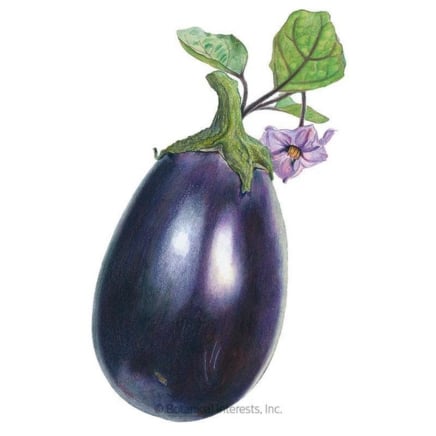
Black Beauty Eggplant Seeds
Sweet Pepper
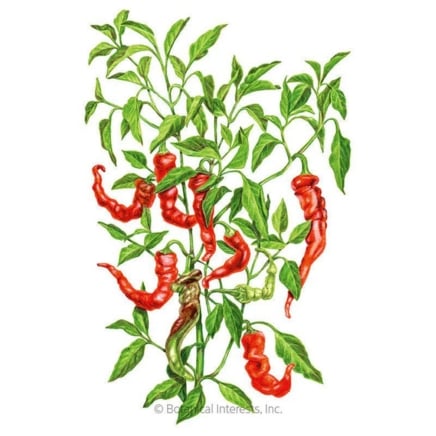
Jimmy Nardello Sweet Pepper Seeds
Arugula
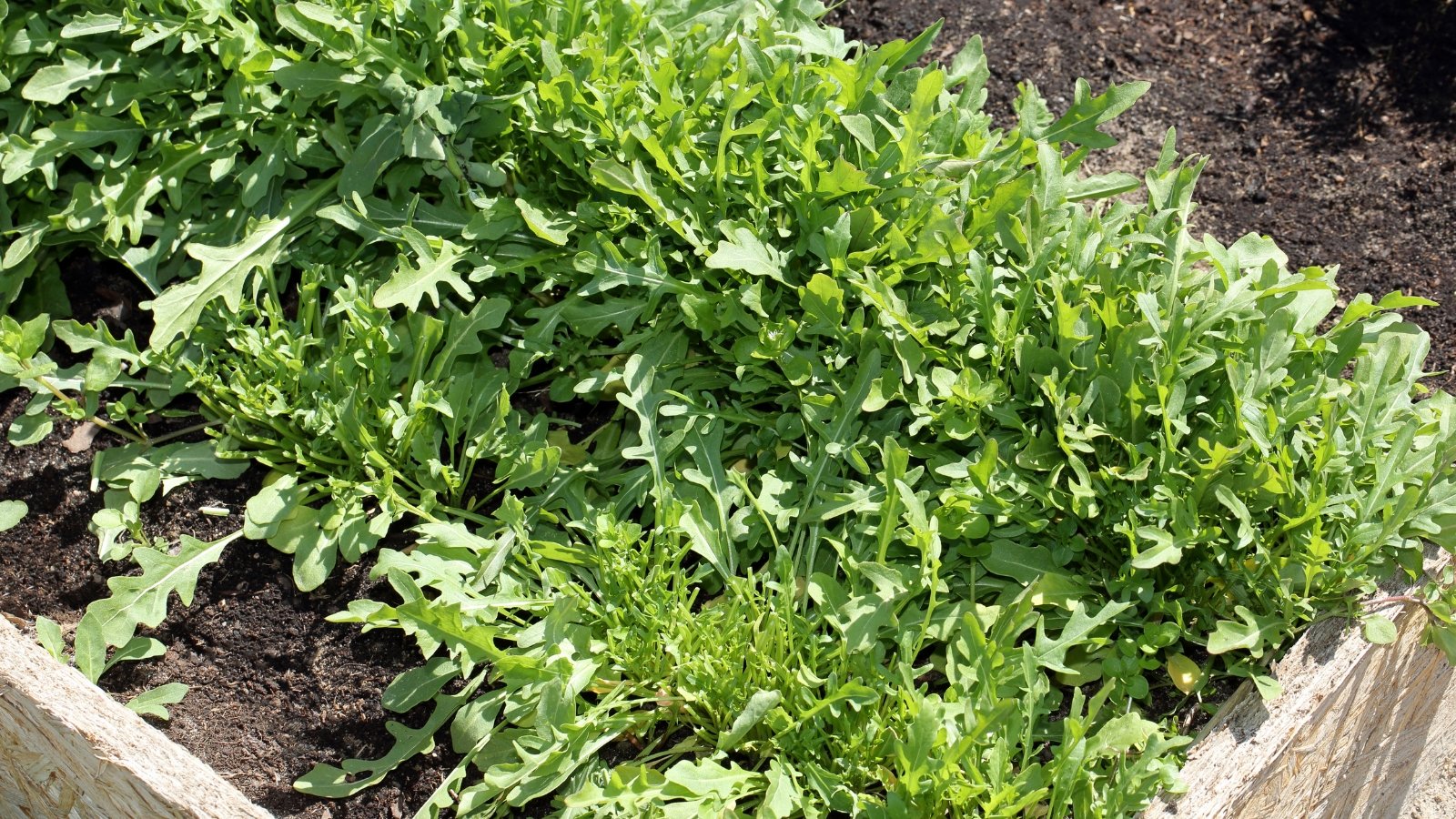
Are you tired of buying containers of baby arugula at the grocery store only to have half the leaves turn yellow and slimy after a few days? Then, take arugula production into your own hands! Not only is arugula easy to grow in raised beds, but the baby greens are ready to harvest in as little as three weeks after you plant the seeds.
While you can transplant arugula seedlings, I recommend direct sowing the seeds. I prefer growing this slightly spicy crop in rows with a few inches of space between each one. This method allows for adequate airflow and also makes harvesting easy.
Since arugula grows quickly, you can plant multiple successions throughout the growing season. Arugula is frost-tolerant, so you can plant your first round of seeds a few weeks before your last spring frost date. You can expect to get two to three harvests off a single planting of arugula, so continue sowing new successions every two to three weeks for a continuous harvest.
Although arugula is a small crop, it’s a heavy feeder that requires lots of nitrogen to thrive. Fertilizing your soil with a balanced fertilizer before planting will keep your arugula leaves dark green and help them fight off pests and diseases. Since arugula is in the brassica family, keep an eye out for pests, including flea beetles and harlequin bugs, and protect the plants with a layer of lightweight row cover if necessary.
Beets
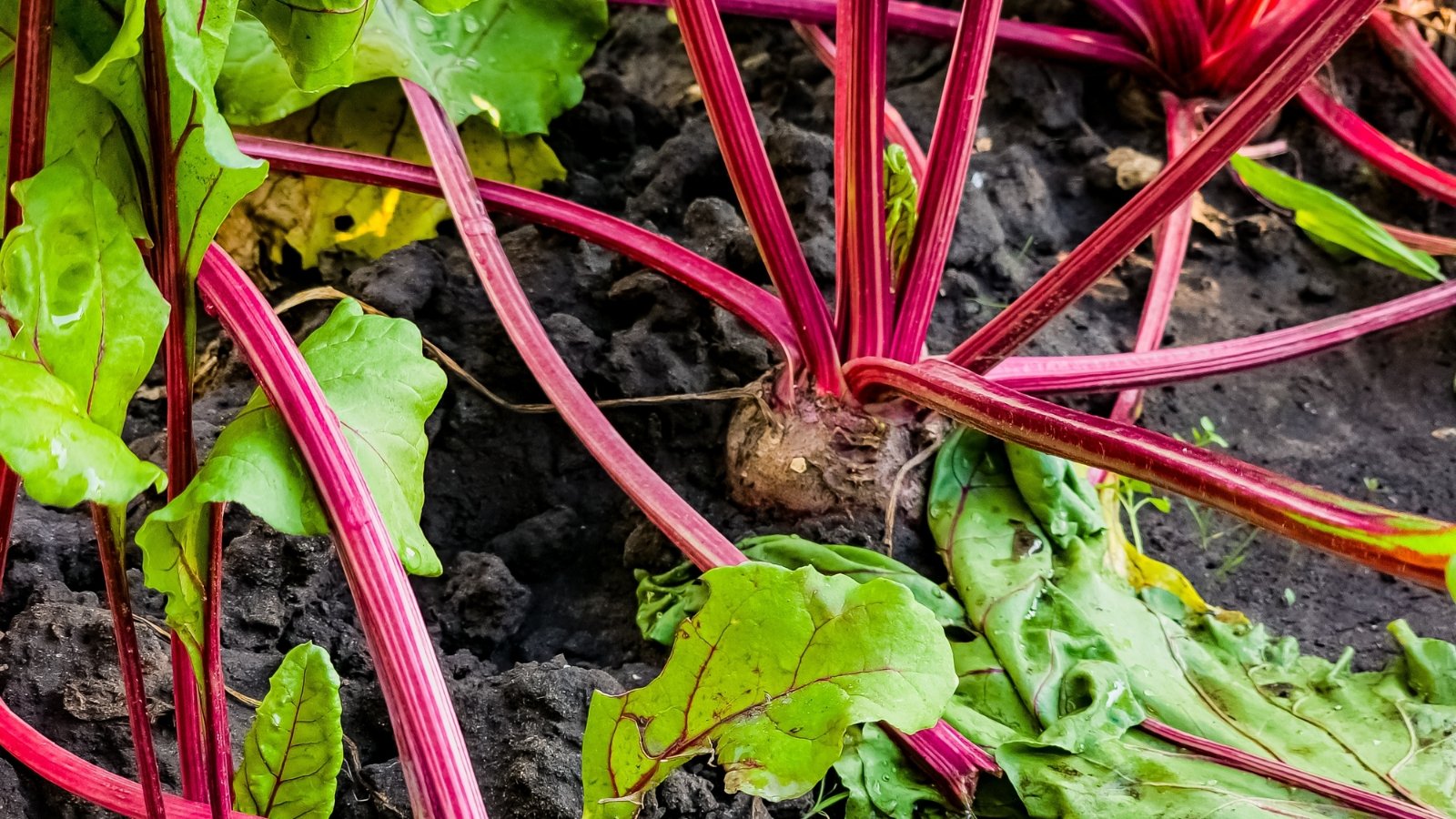
Most people grow beets for their sweet, colorful, and slightly earthy roots, but their tender and nutritious greens are delicious sautéed, mixed into a quiche, or juiced. The beets’ double duty is just one reason why I think they’re a great veggie to grow in raised beds. They’re also easy to grow and fit in well alongside crops including lettuce, kale, and tomatoes.
Since beets have tender roots that hate disturbance, direct seeding is a better option than transplanting. Each beet “seed” is actually a capsule containing multiple individual seeds. So take that into account when you’re spacing your seeds! I find that spacing seeds two inches apart works well—once the seedlings are a few inches tall, thin them to three inches apart, if necessary.
Beets prefer cooler weather, so they’re perfect crops for your spring and fall gardens. While you can try to grow them year-round, the summer heat stresses the plants and makes them more susceptible to diseases like Cercospora leaf spot. Try planting one round of beet seeds in the weeks following your last spring frost, then plant another round of seeds in late summer.
Bok Choy
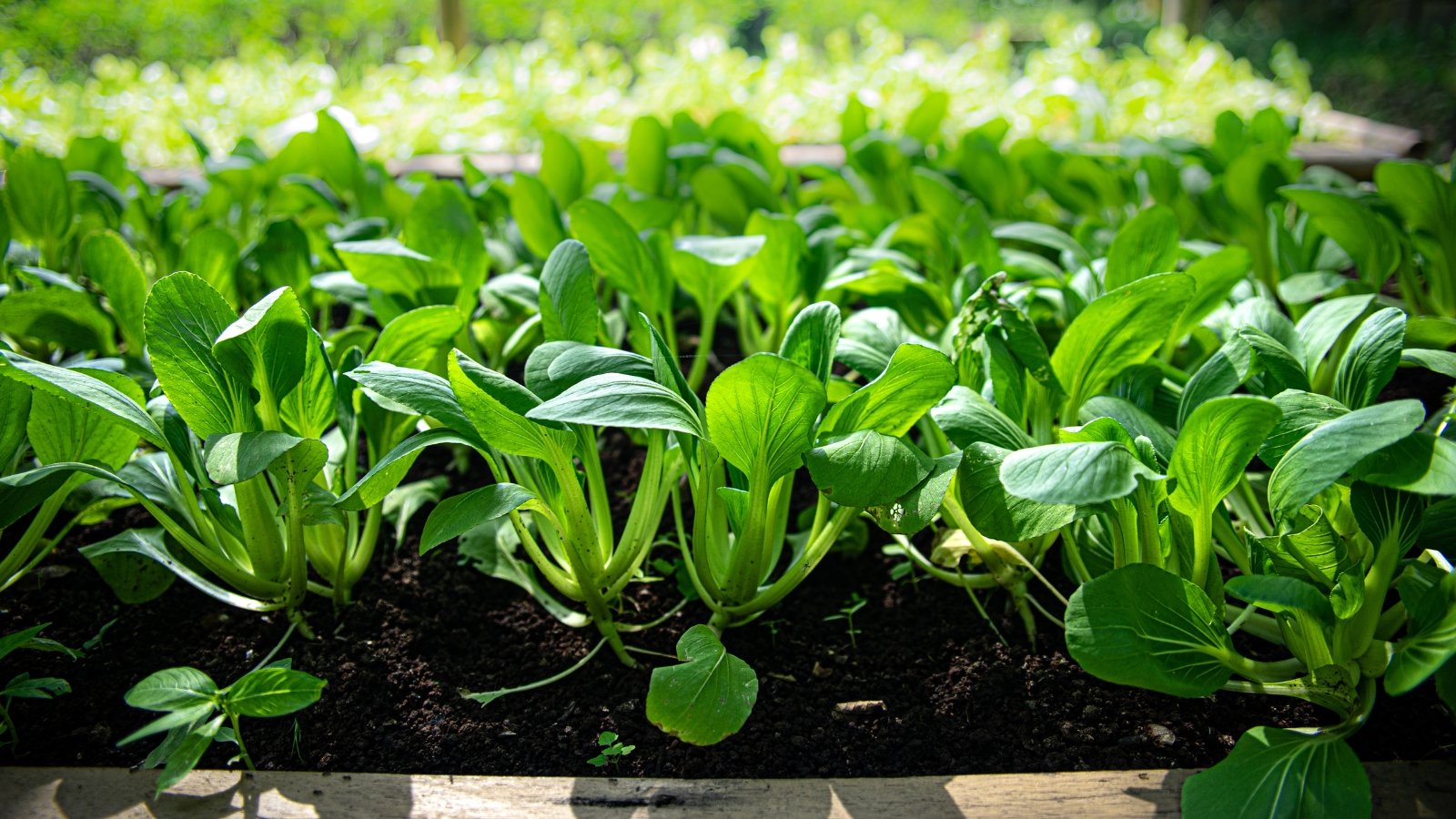
One of the most popular Asian greens, bok choy is easy to grow at home and versatile in the kitchen. It doesn’t hold up well in the heat but tolerates frost, so it’s a great addition to the spring and fall garden. As long as you cover the plants with a bit of floating row cover, they can even survive temperatures down to 20°F (-7°C)!
Growing bok choy at home allows you to take advantage of the many varieties available. While you may come by large bok choy in stores, it’s harder to find tender baby bok choy that brightens up soups and stir-fries. Varieties like ‘Choko’ and ‘Toy Choy’ are fully grown when they’re four to six inches tall, so you can fit multiple plants into small raised beds.
Bok choy grows whether you direct sow seeds or transplant seedlings. I like to start my first round of bok choy seeds indoors and transplant them out into my raised beds a week or so before my last spring frost. Since direct sowing is easier and quicker than transplanting, I plant later successions of bok choy directly in the garden. Spacing baby bok choy seeds two to three inches apart allows for a full crop—if the plants begin to crowd each other, cut a few of them at the soil line to allow for good airflow.
Broccoli
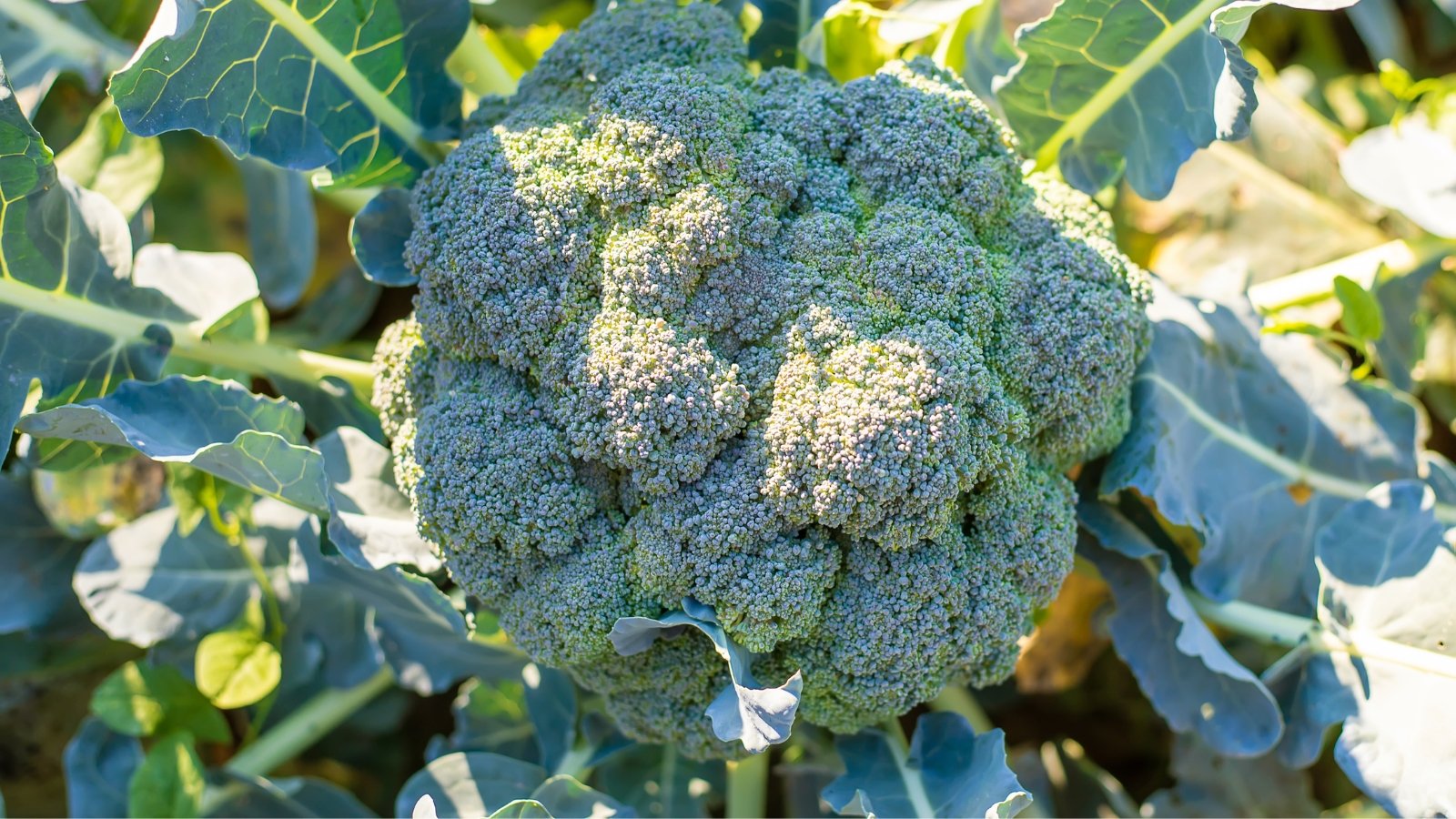
If you’ve never eaten broccoli that was just picked a few hours before, you’re in for a treat. While some people think of broccoli as bitter and tough, this veggie offers tender stems and sweet, crunchy florets when grown in cool conditions and healthy soil. Since this plant thrives in cool weather, the trick is to grow it in the spring and fall.
To get a jump on the growing season, start your spring broccoli seeds indoors about six weeks before your predicted last spring frost. Once the seedlings are two to three inches tall, go ahead and plant them in your raised bed. The seedlings can survive light frosts, but I like to cover recently transplanted seedlings with row cover to help limit their stress.
While you can direct sow fall broccoli, I recommend starting the seeds indoors or purchasing transplants from a local nursery. Pests like flea beetles, harlequin bugs, and cabbage worms love munching on summer broccoli, and larger plants have a better chance of fighting off these pests than small seedlings do. Transplanting seedlings into your raised bed sometime during July, August, or September, depending on your climate
One of the downfalls of growing broccoli is that individual plants take up multiple square feet and only provide you with a single harvest. If you want to save precious raised bed space and enjoy multiple harvests, try planting sprouting broccoli. Varieties like ‘Di Cicco’ and ‘Burgundy’ produce a smaller main head, but their production of side shoots makes up for the reduced first harvest.
Bush Beans
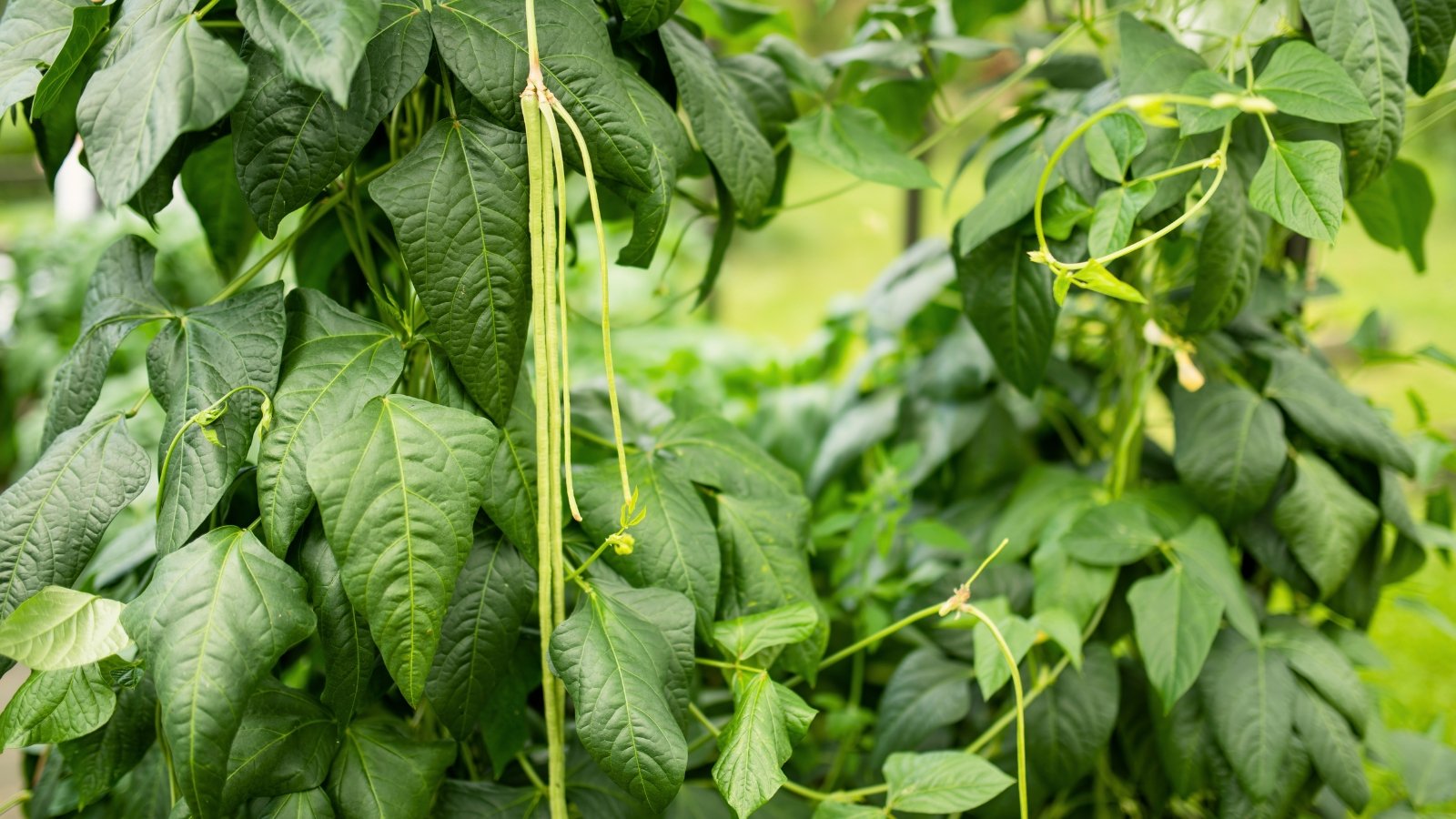
There are many different types of beans out there, but bush beans are my favorite type to grow in raised beds. As their name suggests, the plants grow as compact bushes rather than trailing vines. These plants produce beans that can be enjoyed fresh or shelled for drying—just make sure to choose a variety that matches your intended use.
All types of beans are warm-weather crops, so wait until temperatures are consistently above 50°F (10°C) before planting. Beans grow great when direct sown but you can also transplant them. No matter which option you choose, plant the beans in rows and leave about two inches between each plant.
Bush beans are also a great garden addition if you have kids at home. The large pods are easy targets for tiny hands, and since plants produce beans over multiple weeks, your kids can enjoy honing their harvesting skills. For added fun, plant purple beans like ‘Burgundy’ and yellow ones like ‘Gold Rush.’
Carrots
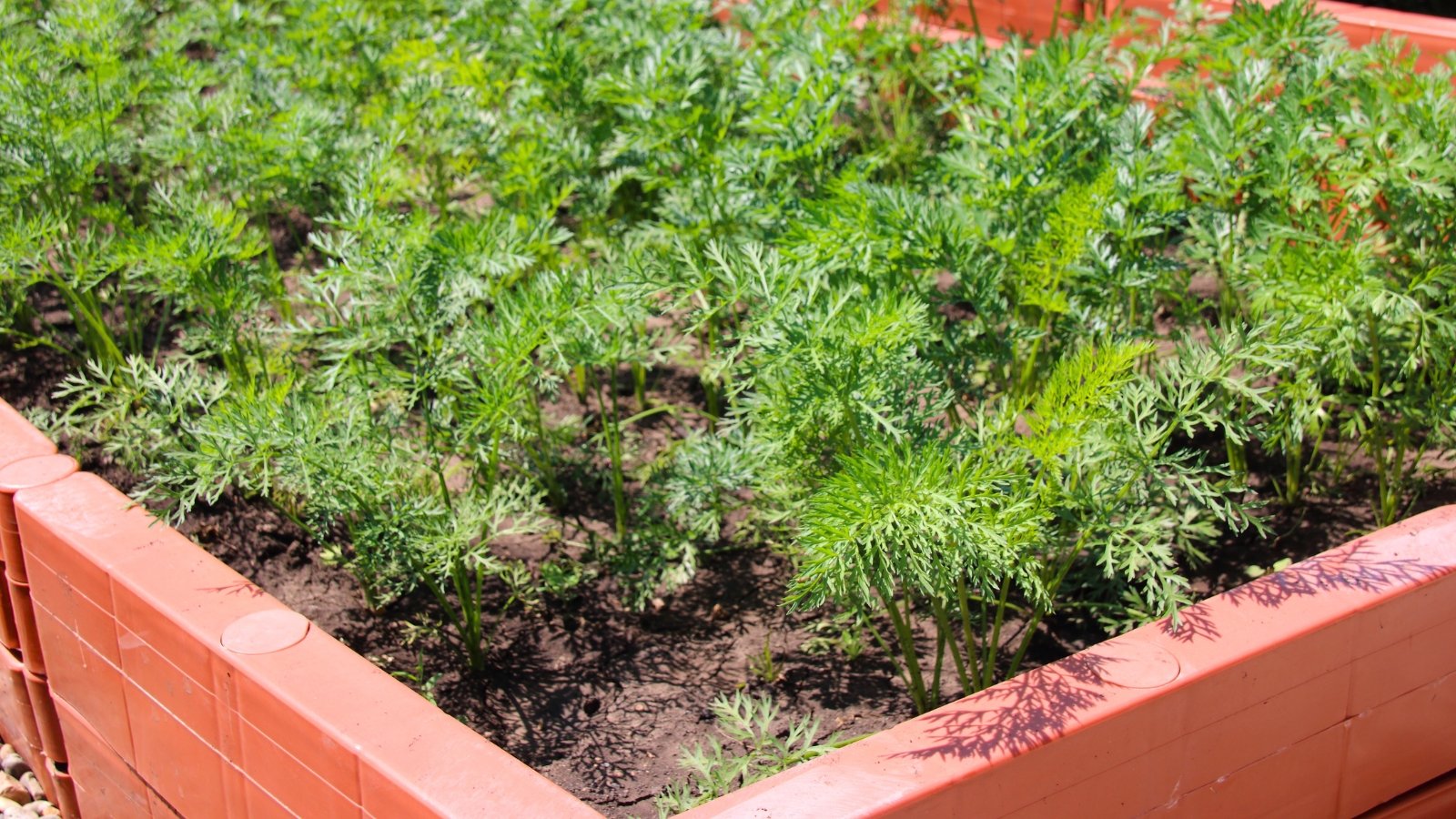
One of the great things about growing in raised beds is they allow you to grow in loose and well-aerated soil regardless of where you live. And that means you can grow long, straight carrots! Since carrots are sweetest during cold temperatures, it’s best to plant their seeds in the spring and late summer. Fall-grown carrots are not to be missed since their roots become extremely sweet after experiencing frost and cold temperatures.
If you want to plant carrots, note that their seeds take 10-20 days to germinate. The seeds must remain moist during this period, so water the soil regularly. Once the carrots germinate, thin the seedlings so they’re one to two inches apart.
Since carrots take a long time to germinate and grow slowly when they’re young, try planting them alongside other crops. Planting a row of carrots beside a row of radishes allows you to get two crops from the same area; the radishes will be ready to harvest by the time the plants become crowded. You can also plant rows of carrots beside a row of tomatoes or peppers.
Cauliflower
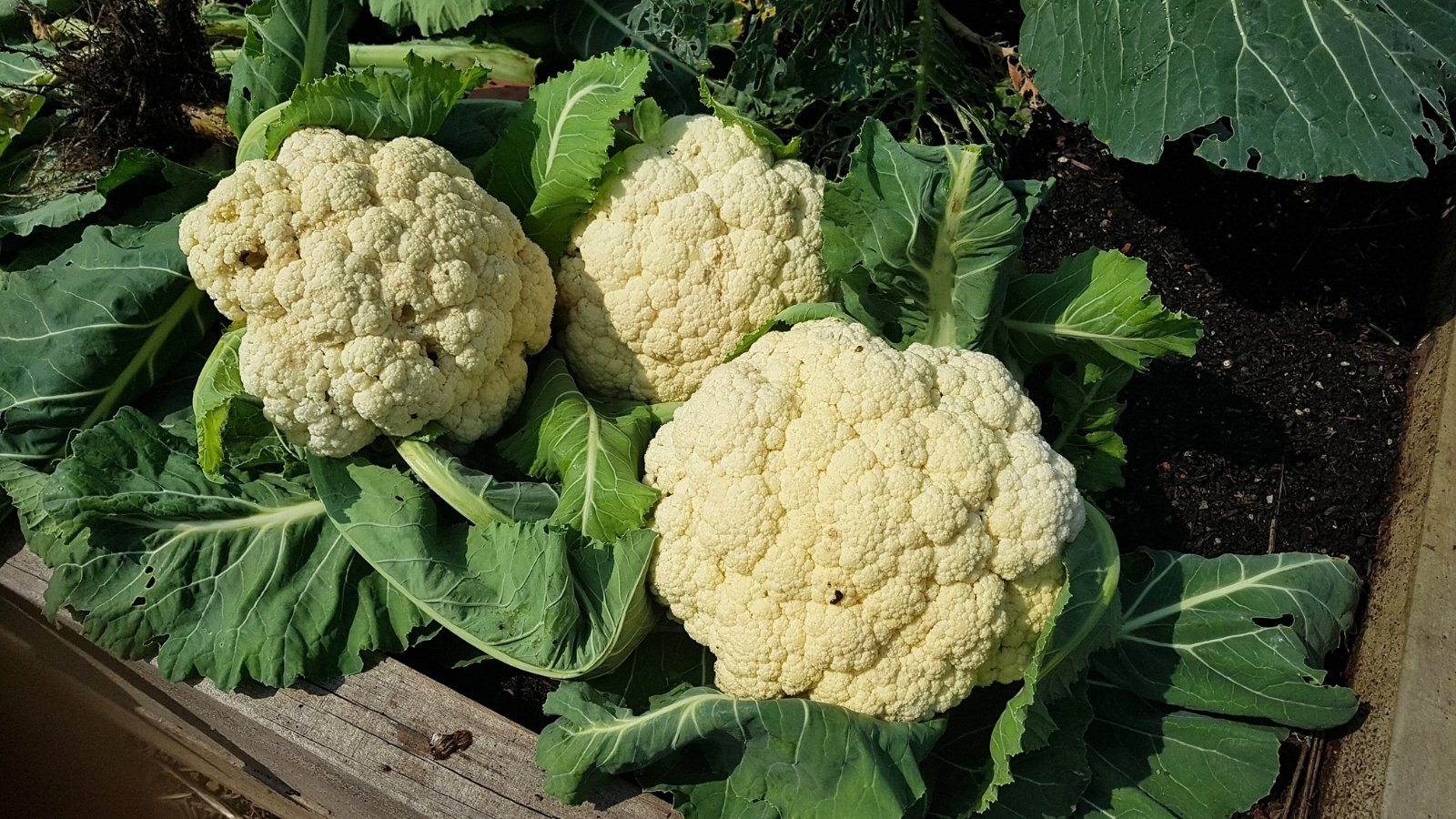
Since cauliflower plants take up so much space, many gardeners choose to skip growing these plants in their raised beds. But if you have a larger raised bed (or are a cauliflower lover like me), you’ll find a way to work this veggie plant into your garden plant.
Cauliflower prefers cool weather and takes multiple months until it’s ready to harvest, so it grows best in the fall. You can also try growing cauliflower in the spring if you live in an area with a long, cool spring. Regardless of when you grow cauliflower, grow the plants from transplants and make sure to plant the seedlings at least a foot away from other plants.
This member of the brassica family is a favorite food of cabbage worms, harlequin bugs, and other pests. Regularly check your plants for these pests and handpick the unwelcome diners or spray them with neem oil. As long as the plants remain healthy, they’ll produce heads of cauliflower two to three months after planting.
Cucumbers
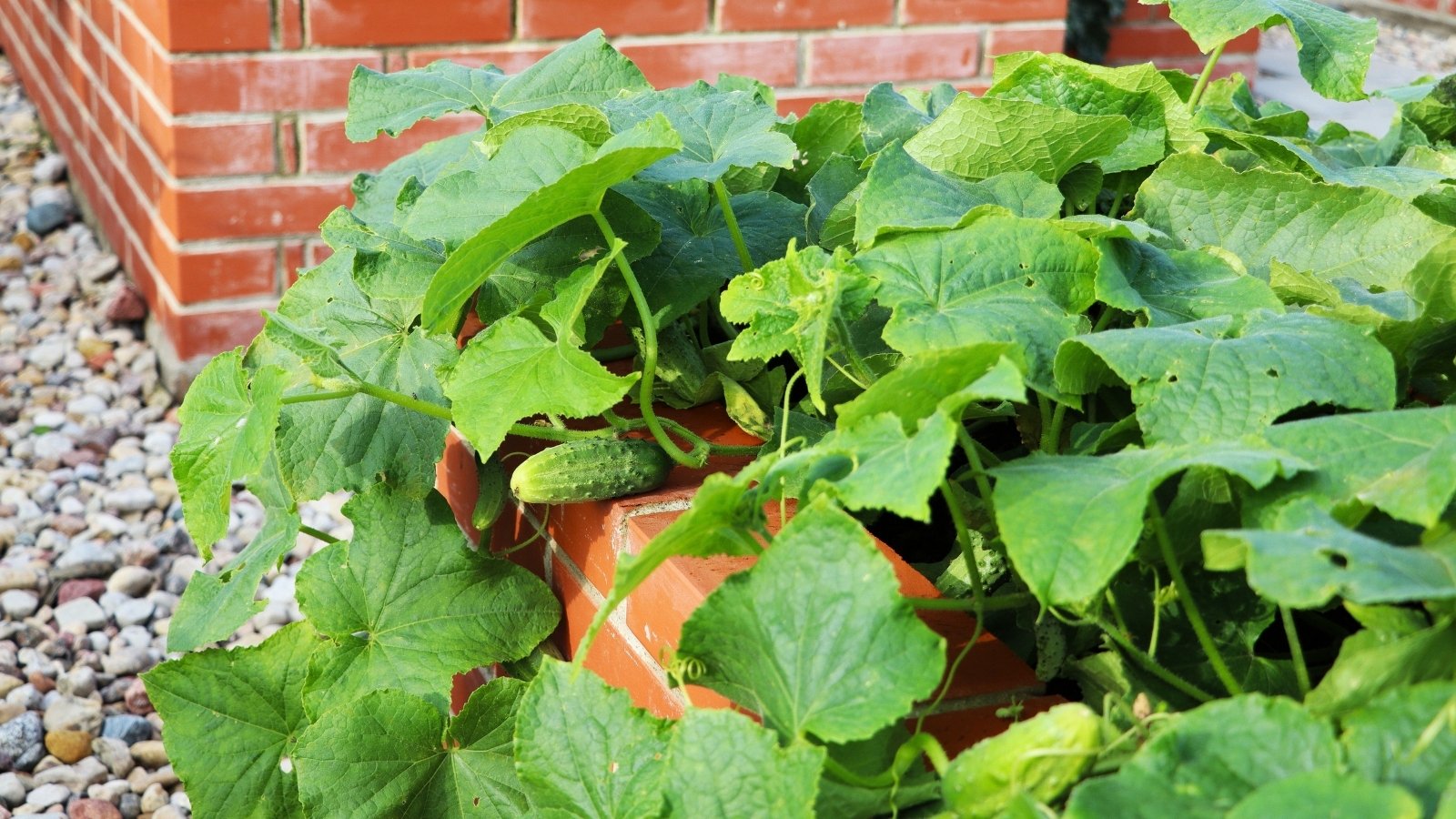
When cucumber plants are healthy, they’re one of the most prolific veggies you can grow in your garden. Ample water and warm temperatures encourage the plants to produce new cucumbers each day, leading to a pile of cucumbers ready to turn into pickles or drop on your neighbor’s porch. However, their growth can also be overwhelming for raised bed gardeners.
Trellising cucumbers is one way to prevent these plants from taking over your entire raised bed. Many different types of trellises are available, so choose one that works well in your garden. You can also grow cucumbers without a trellis, but be aware their vines will sprawl over your raised bed.
No matter how you grow your cucumbers, wait until the weather and soil are warm before you plant them outdoors. Cucumbers prefer temperatures above 55°F (13°C), so wait until nights are consistently warm before planting. Direct seeding prevents you from disturbing the plant’s tender roots; just make sure the soil is above 60°F (16°C) for proper germination.
Eggplant
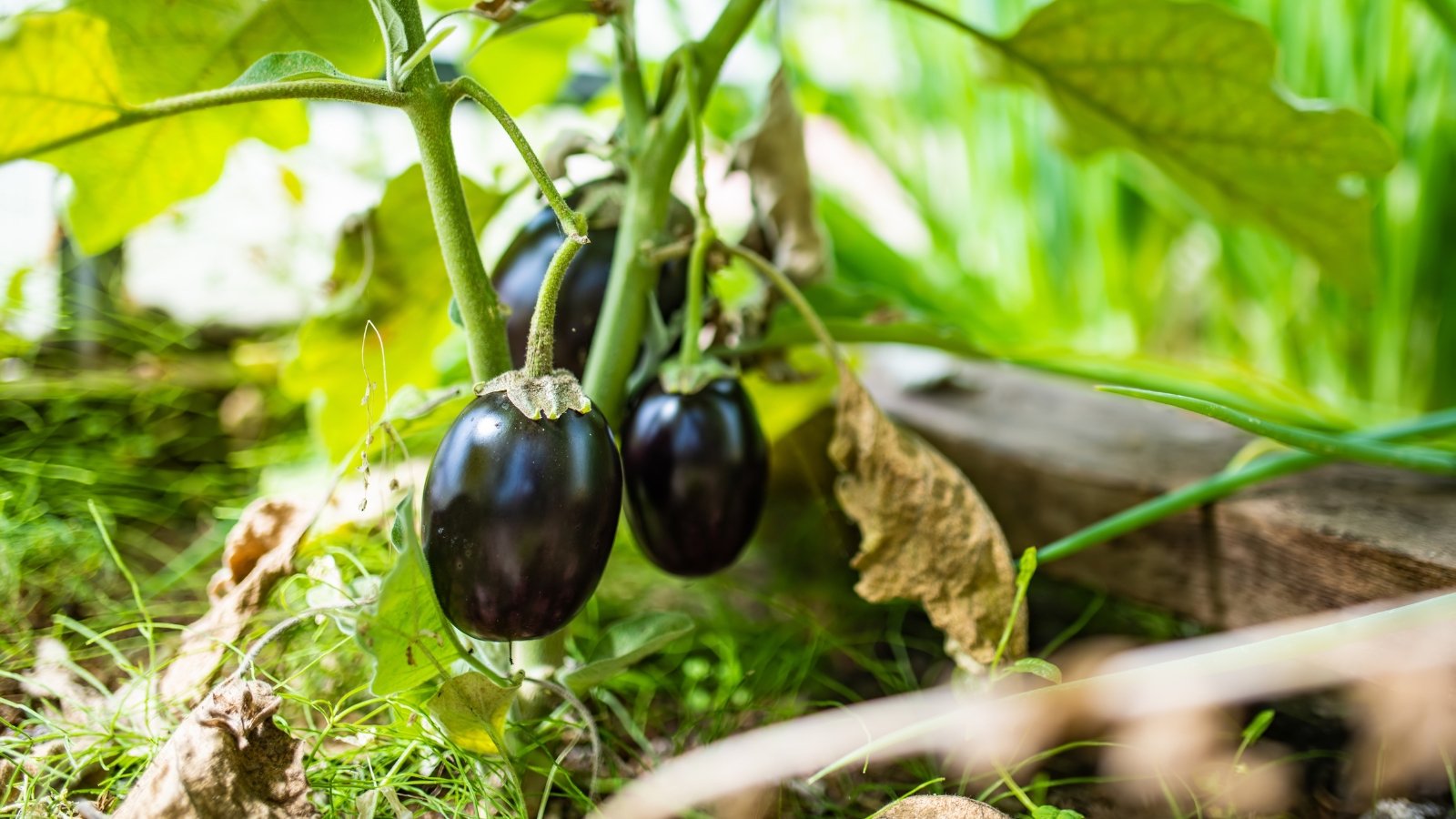
Dreaming of baba ganoush, eggplant parmesan, or other tasty dishes? Then try growing eggplant in your raised beds this summer! Eggplant thrives in warm weather, so it’s a great addition to raised beds, even if you live in an area with oppressively hot summers. The plants continue to produce new fruits for multiple months, so you can plant a single plant and enjoy many harvests.
There’s nothing wrong with the classic deep-purple Italian eggplant varieties like ‘Black Beauty,’ but you can also experiment with other varieties. For example, ‘Jewel Amethyst’ produces small teardrop-shaped fruits, and ‘Long Purple’ produces long, skinny Asian-type eggplant.
No matter which variety you grow, start the seeds indoors or purchase seedlings from a nursery. Since eggplants are extremely sensitive to cold, wait until nighttime temperatures remain above 50°F (10°C) before adding the seedlings to your raised bed. Flea beetles love eggplant leaves, but covering the plants with row cover protects them from pests. Just remove the cover once the plant begins producing flowers.
Garlic
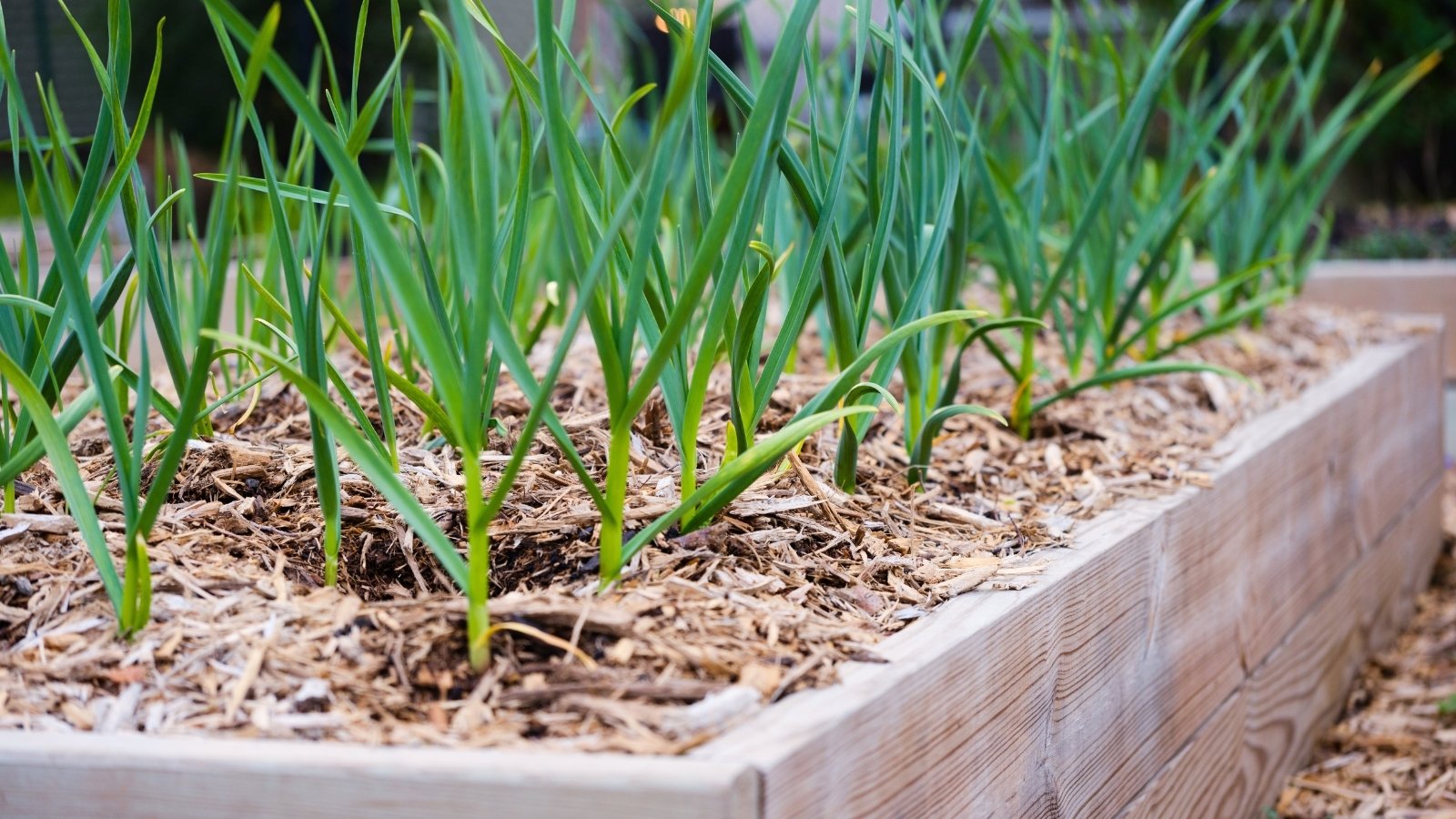
If you’ve never grown garlic before, you’re in for a treat! The flavor of fresh garlic is heads and shoulders above that found in grocery stores. And since you plant garlic in the fall and harvest it the following summer, you can fill your raised beds in the winter instead of letting them remain empty.
There are two main types of garlic: softneck and hardneck. Softneck is often found in grocery stores due to its long storage life, and it works better for growers in warm areas. Hardneck varieties often produce larger cloves with a more robust flavor, and the plants send up tasty flower stalks known as garlic scapes. There are hundreds of varieties of both softneck and hardneck garlic, so take some time to choose a variety that matches your climate and flavor preferences.
Planting garlic involves sticking entire cloves into the ground. After you’ve tucked the cloves into the ground, cover them with a layer of mulch to insulate the plants and keep weeds at bay. While the plants won’t grow much over the winter, they’ll resume rapid growth the following spring.
Kale
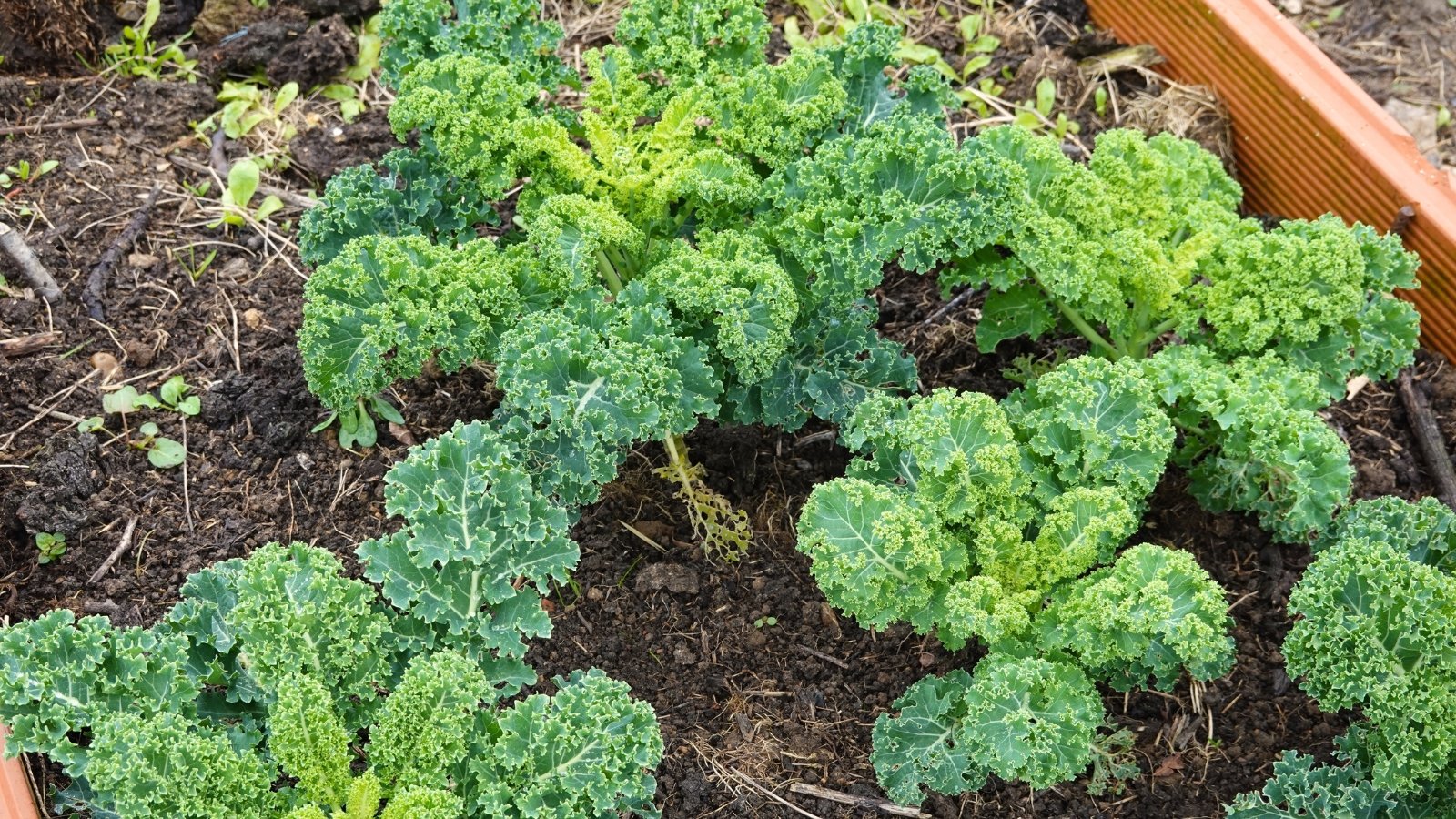
If you only grow one type of green in your garden, kale is an excellent option. You can enjoy the leaves both raw and cooked, and the plants continue producing new growth as long as you harvest the outermost leaves. And since there are so many different varieties of kale, you can choose one that suits your palate.
All types of kale are cool-weather crops that grow best in the spring and fall. Warm weather encourages them to bolt (produce flower stalks), brings in unwelcome pests, and causes the leaves to become tough and bitter. If you want to grow kale in both the spring and fall, plant one round of seeds in the early spring and another in the late summer.
If you want your kale to grow well for multiple months, make sure to provide the plants with enough nutrients. Kale plants need moderate amounts of nitrogen, potassium, and phosphorus to support their growth, so add a balanced fertilizer or a dose of finished compost before planting.
Lettuce
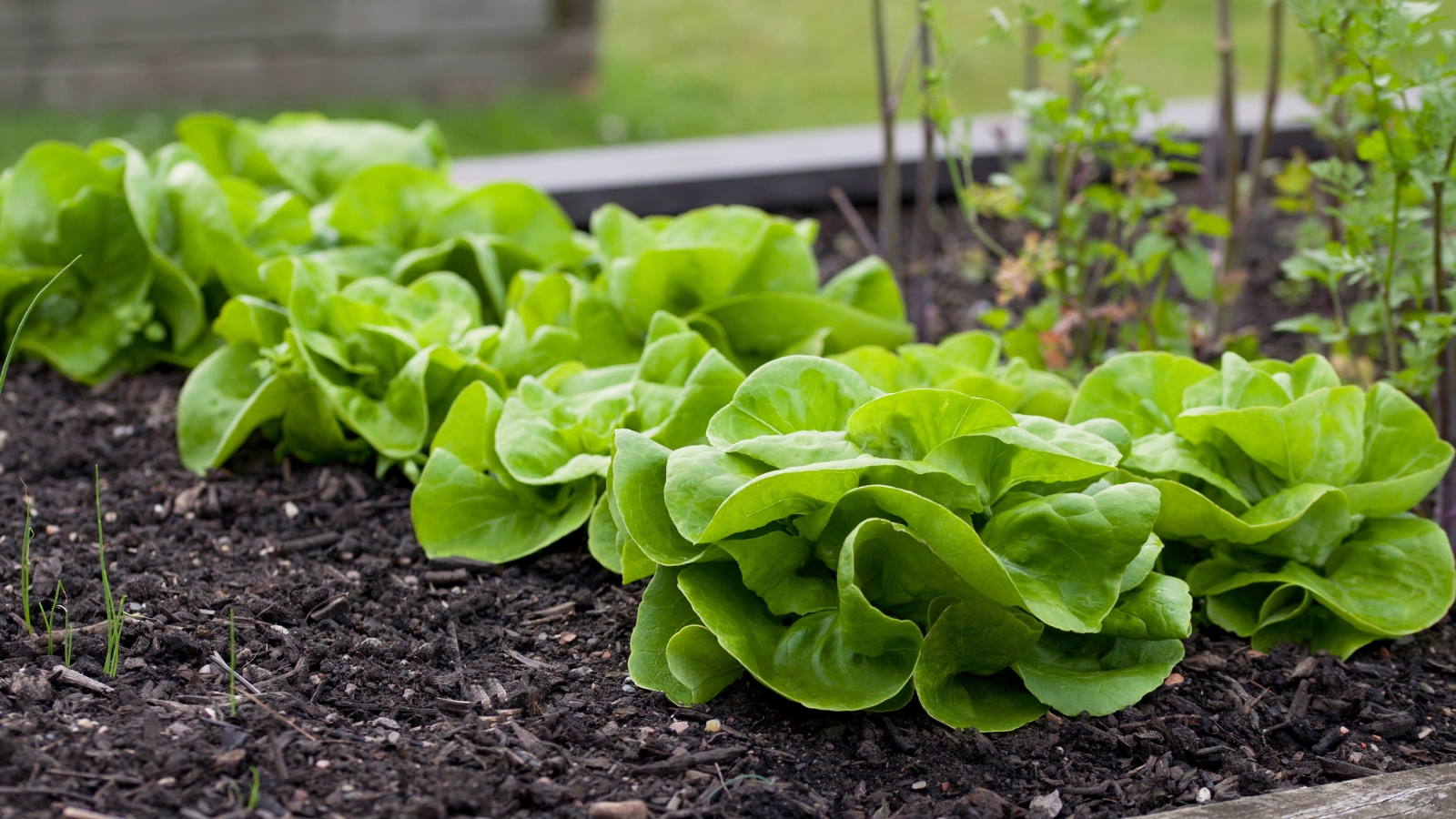
If you’re new to gardening, lettuce is one of the easiest crops to grow…as long as you plant it in the proper season. Almost all lettuce varieties grow best in cool weather when temperatures remain below 80°F (27°C). Hot weather causes the plant to flower, aka bolt. While you can still eat bolted lettuce, the leaves will be bitter and tough. Therefore, the spring and fall are the best time to plant lettuce in your raised beds.
Lettuce grows well when direct sown in your garden or transplanted. If you want to grow baby lettuce for salads, you can sprinkle five to ten seeds per inch and cut the greens when they’re a few inches tall. Since full lettuce heads require more space to size up, leave ten inches between each plant.
While there’s nothing wrong with a classic head of crunchy romaine or a supple butterhead, don’t be afraid to play around with new-to-you lettuce varieties. After all, growing new varieties at home is one of the fun parts of gardening! Some unique varieties to check out include ‘Ice Queen,’ ‘Rouge d’Hiver,’ and ‘Red Sails.’
Onions
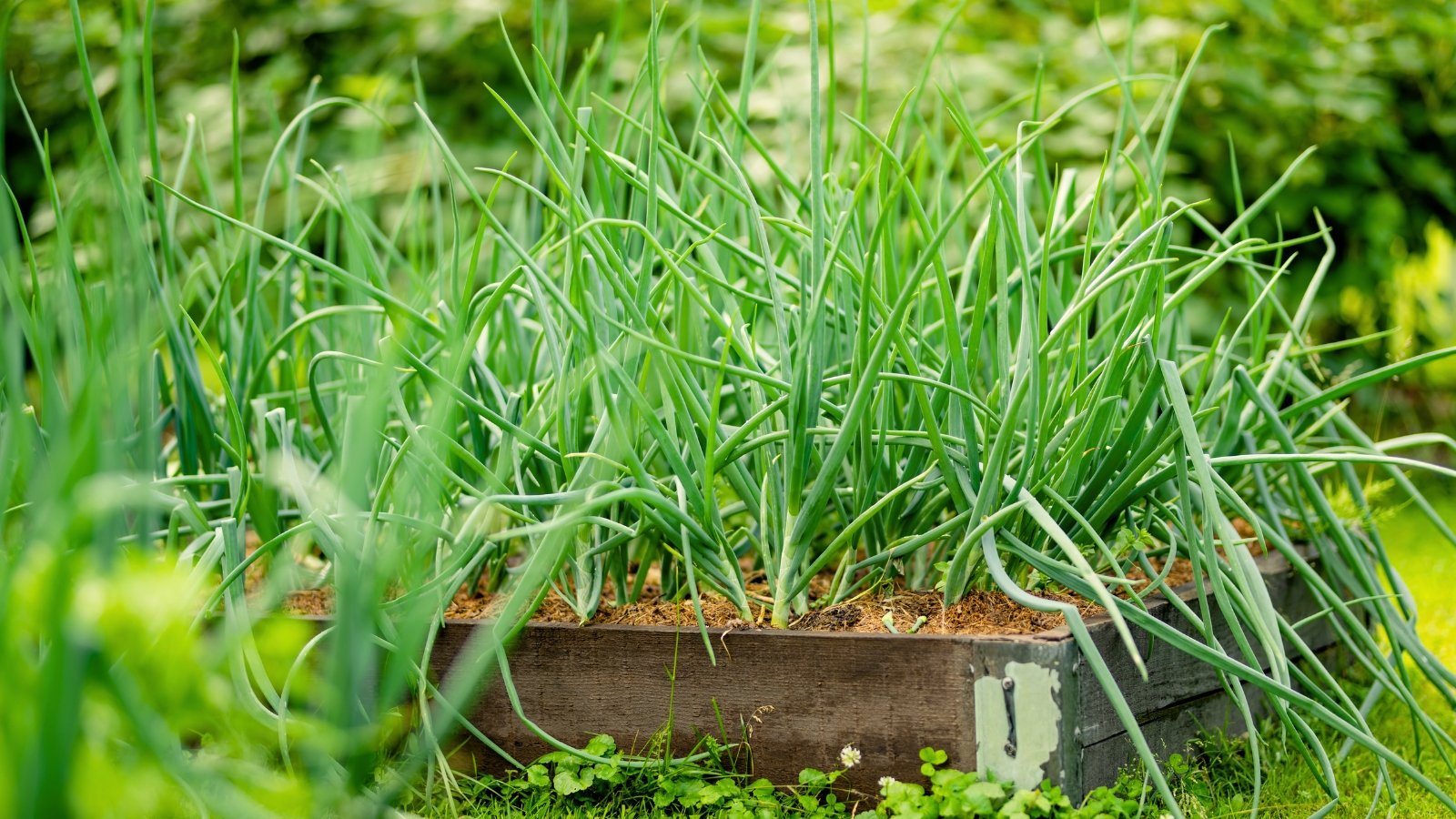
One of my favorite vegetables to grow at home is the humble onion. Although you can grow storage onions to keep in your pantry, I love harvesting fresh onions in the early summer and chopping up the bulbs and greens to add a burst of flavor to my dishes. Plus, there’s nothing like the beauty of a fresh red onion!
There are many different ways to plant onions, and one way is necessarily better than the others. Some popular options include planting small dormant onions known as sets, growing onions from seed, and planting onion transplants. No matter which option you choose, make sure to pay special attention to the variety.
The process of onion bulbing is day-length dependent, meaning the plants must experience a certain number of hours before they can form a bulb. That’s why you see people refer to onions as short-day, intermediate-day, or long-day. Short-day onions are best suited for southern areas with short days, while long-day onions are perfect for northern states.
In zones seven and below, your best bet is to plant onions in the spring after the last frost has passed. Growers in zone eight and above can plant their onions in the spring or plant them in the fall and let them overwinter. Overwintered onions are ready to harvest earlier, but they may require pieces of row cover to protect them from winter temperatures below 30°F (-1°C).
Peppers
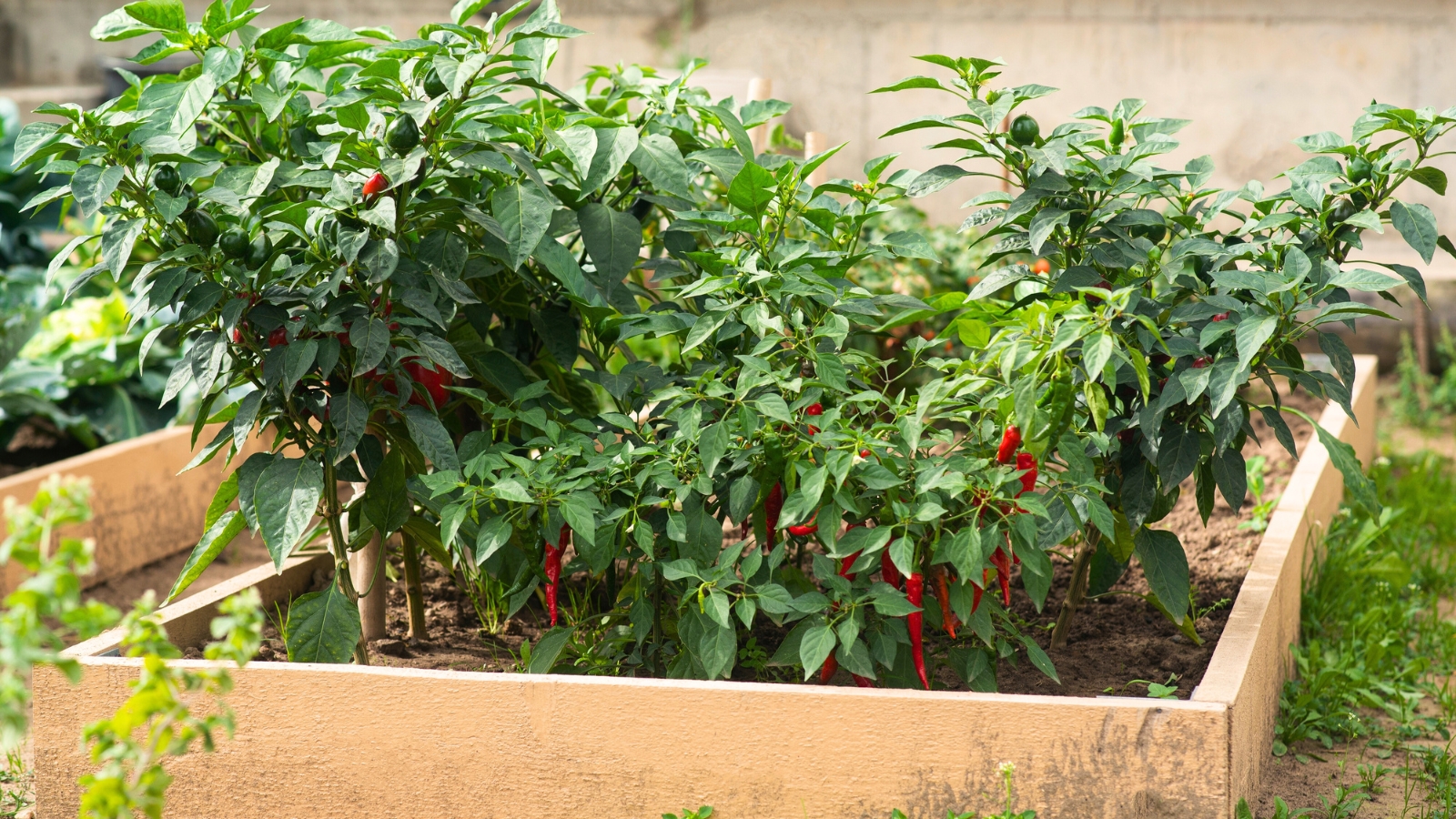
If you live in zone five and above, add peppers to your list of veggies to grow this year. While these plants require multiple warm months before they can produce ripe fruits, the wait is worth it! Once plants begin producing, they continue cranking out new peppers until frost arrives.
Since peppers are slow-growing and cold-sensitive, I recommend starting seeds indoors in the late winter or early spring. Once nighttime temperatures are consistently above 50°F, you can transplant the seedlings in your raised bed. Peppers are heavy feeders, so ensure your soil has adequate nitrogen before planting. If you’re not sure, add some worm castings, finished compost, or balanced organic fertilizer to the soil before planting.
When it comes to selecting which type of pepper to grow, you have many options. If you want to grow sweet peppers, you can opt for classic bell peppers or heirloom options like ‘Jimmy Nardelo.’ And if you want to make hot sauce or chili flakes, try planting a variety like ‘Cayenne Blend’ or ‘Serrano.’
Potatoes
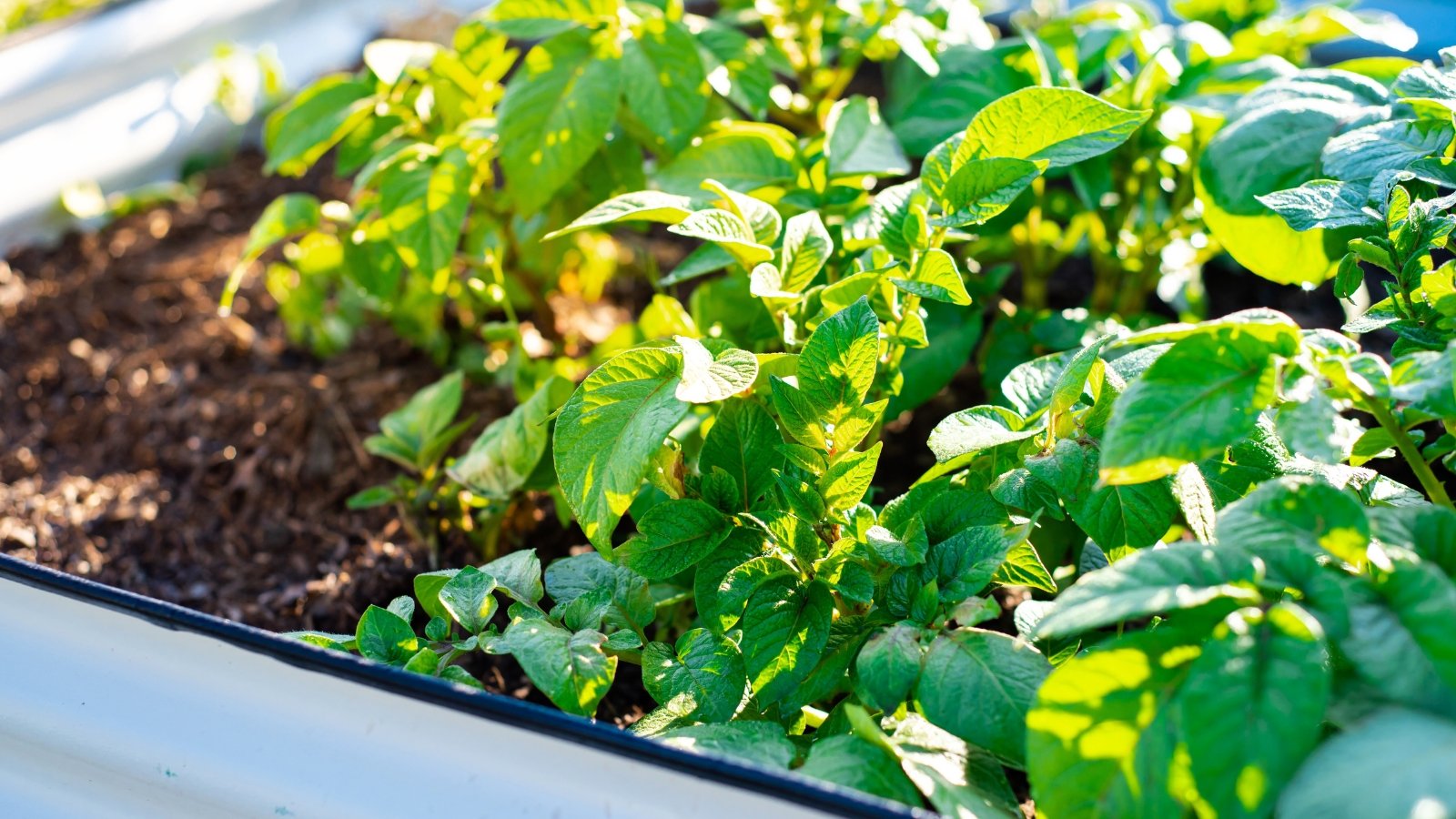
Some people think you have to have a large yard or field in order to grow potatoes. But the truth is you can easily grow them in containers and raised beds! By the time your potato plants are big and green, starchy tubers will be hiding under the soil surface, just waiting to be dug up.
If you want to plant potatoes in your raised bed, make sure to give them plenty of space. The plants require a moderate amount of room to grow, and digging up the tubers will disturb the surrounding soil. Therefore, avoid planting anything within a foot of your potato plants.
The best early to late spring is the best time to plant potatoes. You’ll plant entire potatoes, or potato pieces that contain at least one healthy eye, in the ground. The eyes will sprout and begin producing a plant. Since it can be difficult to determine when your potatoes are ready to harvest, use the variety’s days to maturity as a guide.
Radishes
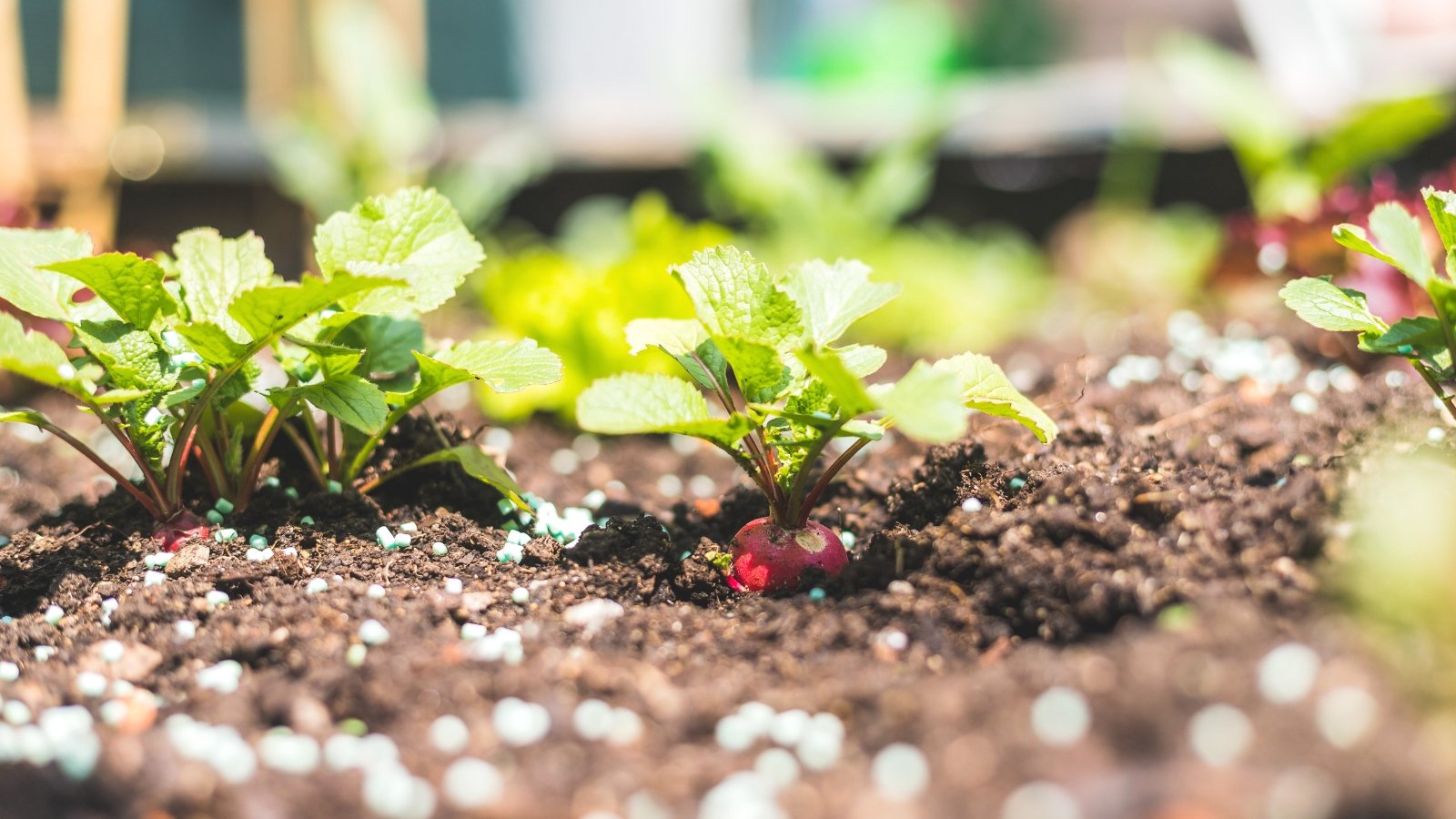
Radishes are ready to harvest in as little as three to four weeks after planting, making them a great crop for impatient gardeners. They’re best planted from seed since the roots prefer not to be disturbed. Leave one to two inches between each seed, depending on the variety.
Most radishes prefer the cool temperatures that occur during spring and fall, but you can get away with growing small radishes in early summer. These plants prefer moist soil during their first week of growth, and they thrive in soil that’s been amended with nitrogen-rich fertilizer or a well-finished compost.
Since small radishes like ‘Cherry Belle’ are ready to harvest in less than a month, you can tuck them beside slower-growing veggies. Try tucking a few radishes eight inches away from your tomato plants or alternating rows of carrots and radishes. The quick-growing radishes will help shade out weeds and be ready to harvest by the time the other crops need more room to expand.
Scallions
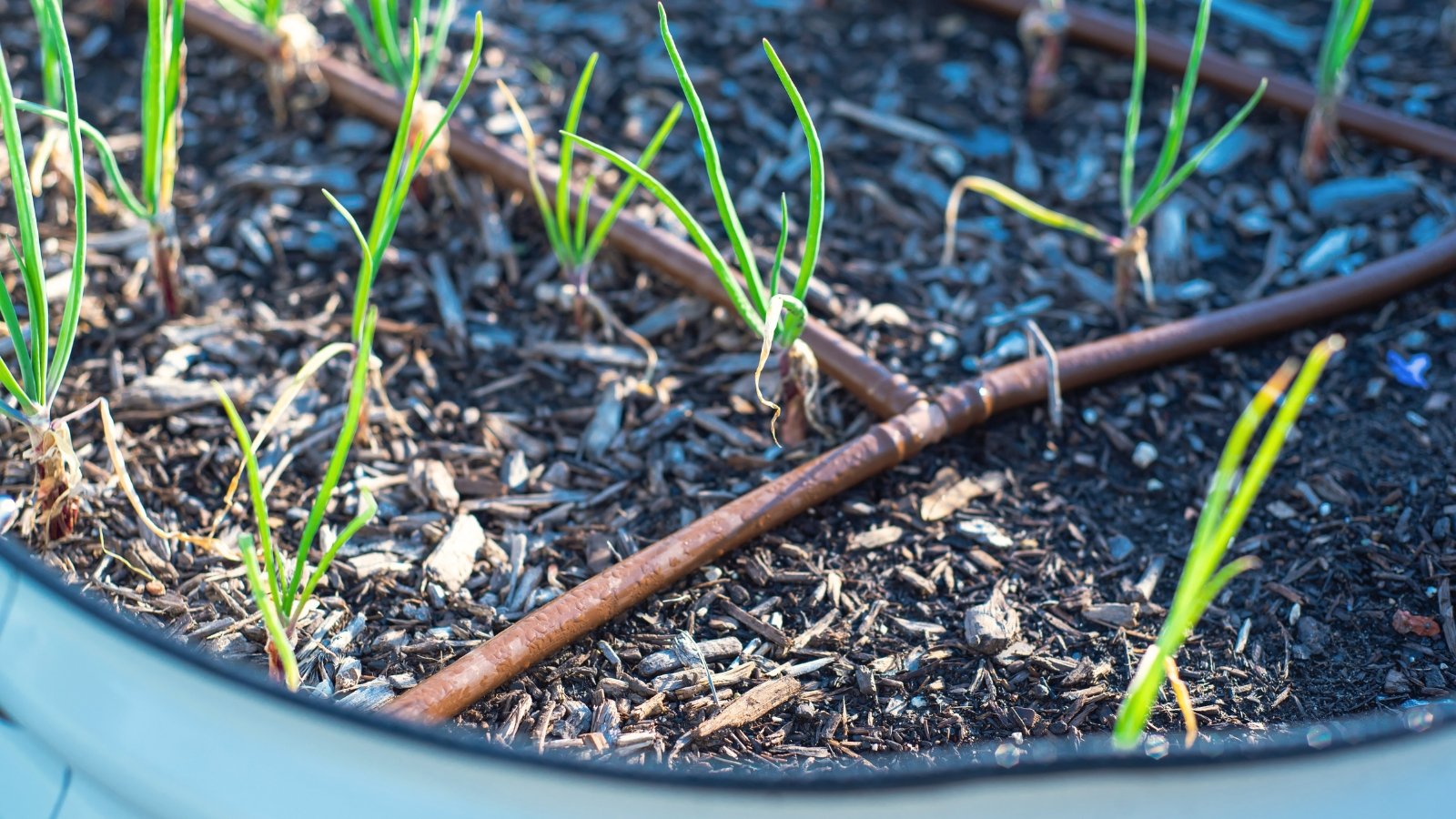
Although scallions are a type of onion, I like to give them their own recognition. Also known as green onions, scallions are a specific member of the onion family that will never form a bulb. This crop is one of the easiest to grow, and if you select the proper variety, you can grow them almost all year round.
You can direct seed or transplant scallions in a raised bed. Regardless of which option you choose, note that tight spacing works just fine. If you’re starting seeds in 72-cell trays, place five or six seeds per cell. Then, transplant the entire clump of seedlings. If you’re direct sowing seeds in a row, plant three or four seeds per inch.
You can harvest scallions at any size, but pencil width is standard. To harvest, grab the scallion(s) by its white base and give it a firm but gentle tug.
Spinach

Spinach is a must-have for an early spring and fall garden. This green thrives in cool weather and becomes supremely sweet once below-freezing temperatures arrive. If you harvest the outer leaves and leave the inner leaves to grow, you can enjoy multiple harvests over the course of weeks or months.
There are many different spinach varieties that vary in leaf texture, heat tolerance, and growth rate. You can harvest any variety when the leaves are small for baby spinach or let them grow larger for cooking spinach. If you want to grow baby spinach, you can space the plants one to two inches apart. But if you want large leaves, allow six inches between plants.
Direct sowing this crop is easy and allows you to grow enough greens for a big salad or lasagna. You can plant spinach seeds in a row or utilize block planting. Overseeding is a good choice since you can easily thin excess seedlings after they emerge.
Swiss Chard
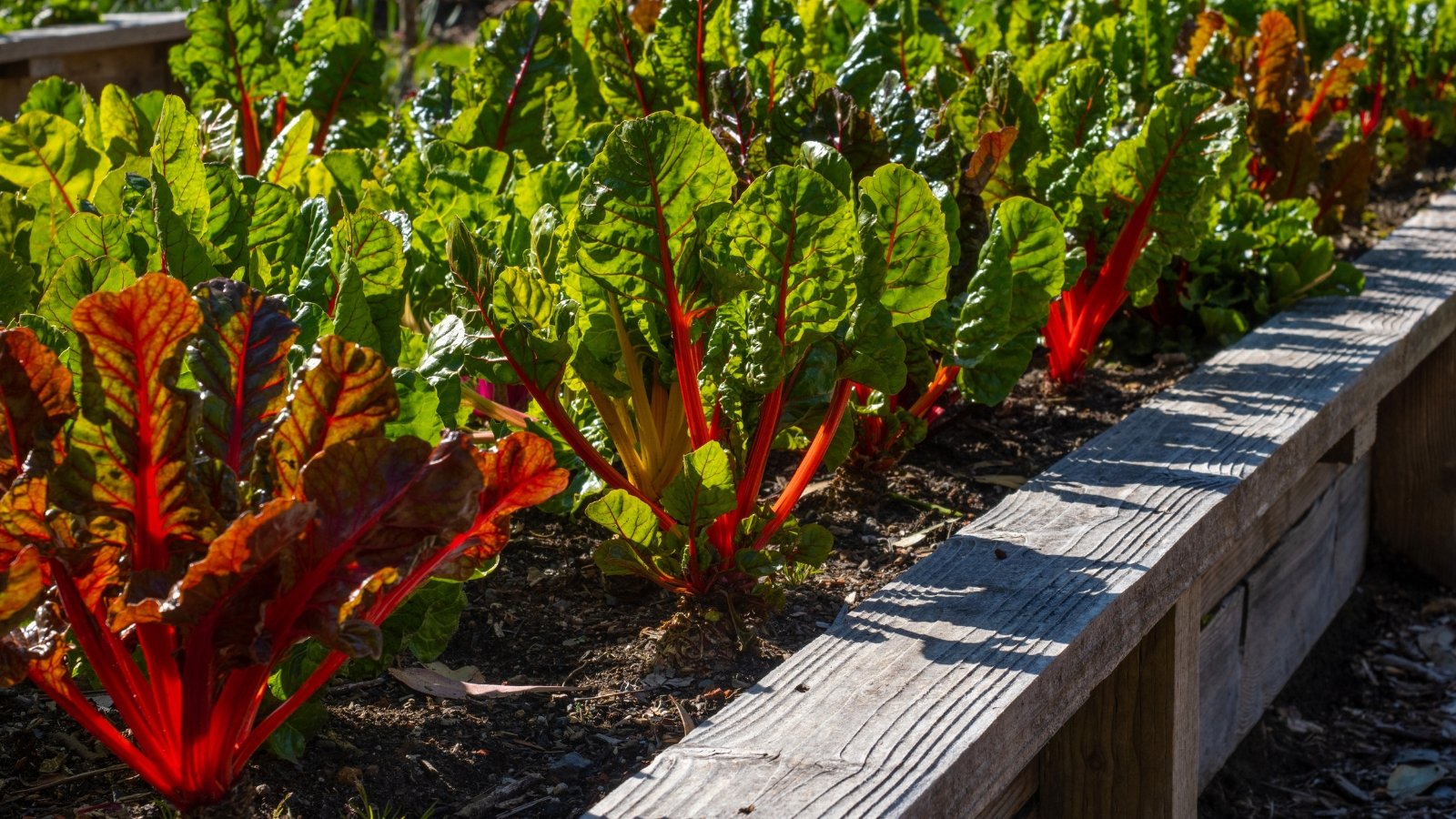
A member of the beet family, Swiss chard produces large leaves with crunchy and sometimes colorful stalks. Both the leaves and stems are edible, and they make great additions to pasta, quiches, curries, and more. Although chard thrives in cooler weather, it can tolerate more heat than greens like kale and collards.
Transplanting chard is preferred over direct seeding since it allows you to get a head start on growing and ensures proper spacing. When you transplant Swiss chard seedlings, space them 10-12 inches apart. Harvest the outermost leaves by cutting the stalks at their base; this will allow new leaves to grow and lead to a continuous harvest.
Although a single Swiss chard plant may remain healthy during the summer in cooler climates, plants often become stressed with high heat. Therefore, don’t be afraid to pull diseased or bug-damaged plants in the summer and plant new seedlings in the early fall.
Turnips
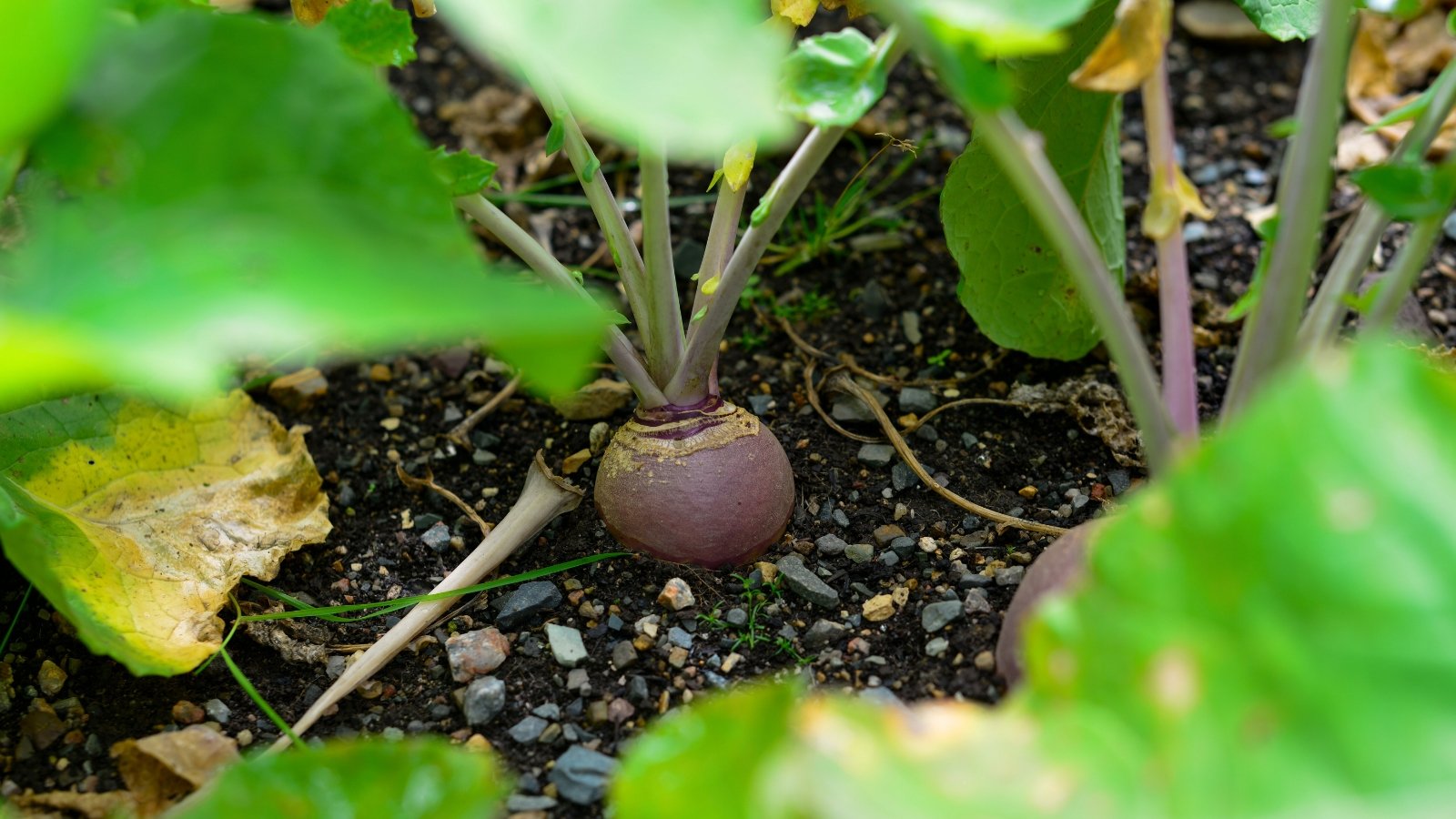
If you’re used to the old, bagged turnips you find in stores, try growing your own turnips at home. Not only will this allow you to select tender varieties that don’t hold up well during transport, but it will also let you enjoy the turnip roots and greens! If you’re looking for a new variety to try out, check out sweet and tender ‘Market Express.’
All turnips prefer cool weather, so you can plant them in the spring and fall. Direct sowing the seeds in your raised bed is best. I recommend planting two seeds per inch and then thinning the seedlings so they’re two to three inches apart.
You can harvest turnips at any size, but larger roots obviously provide more to eat. However, don’t let the roots become too big, or you risk them becoming tough, pithy, and/or bitter. Salad turnips like ‘Market Express’ taste great when the roots are two inches in diameter and cooking turnips like ‘Purple Top White Globe’ are great when three to four inches across.
Zucchini
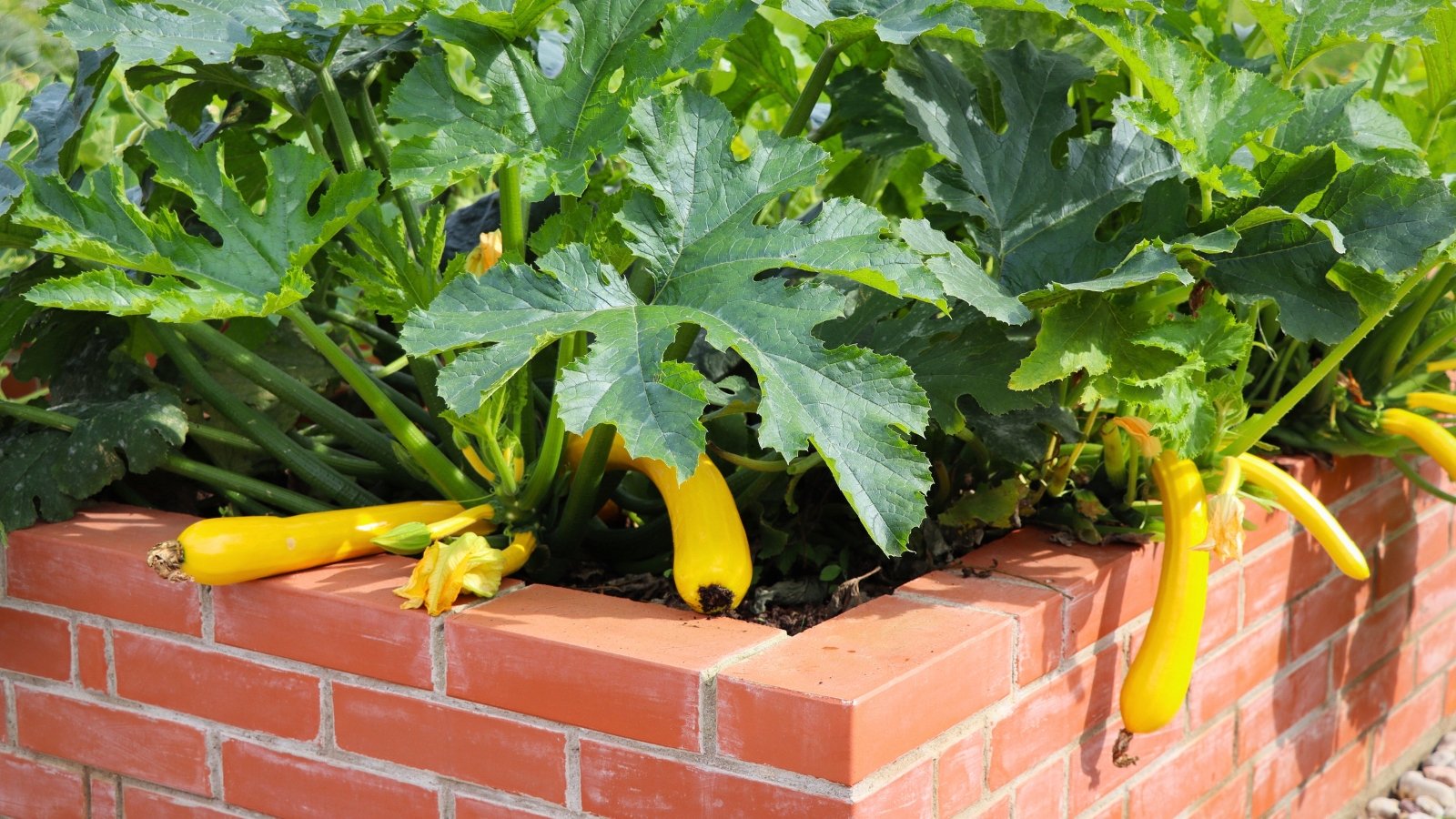
An easy crop for most home gardeners to grow, zucchini plants are the gifts that keep on giving. Warm temperatures and sunny days encourage the fruits to grow at an impressively quick rate, leading to daily harvests. But before you can enjoy your bumper crop, you have to grow healthy plants!
Zucchini plants thrive in warm weather, so wait until temperatures remain above 50°F (10°C) before planting them outdoors. You can direct sow seeds if the soil is warm, and transplant seedlings to give your plants a head start. Since zucchini plants typically produce fruits for three to four weeks, plant a new succession of seeds every month for a continuous harvest.
Unfortunately, zucchini plants are susceptible to numerous pests and diseases. Keep an eye out for squash bugs and squash vine borers, and remove the bugs if you see them. To keep water off the plant’s leaves and prevent the development of fungal diseases, water your plants via drip irrigation or use a watering can to apply water near the base of the plant.
Final Thoughts
Since so many different vegetables are well-suited to raised beds, one of the hardest parts of gardening will be deciding what to grow! Remember that you can start with a few crops and add on more as you go. Take it from me: gardening is a lot more fun when things feel under control! With that said, learning from your mistakes is one of the fun parts of growing vegetables. Even after ten years of growing, I learn something new each year!




